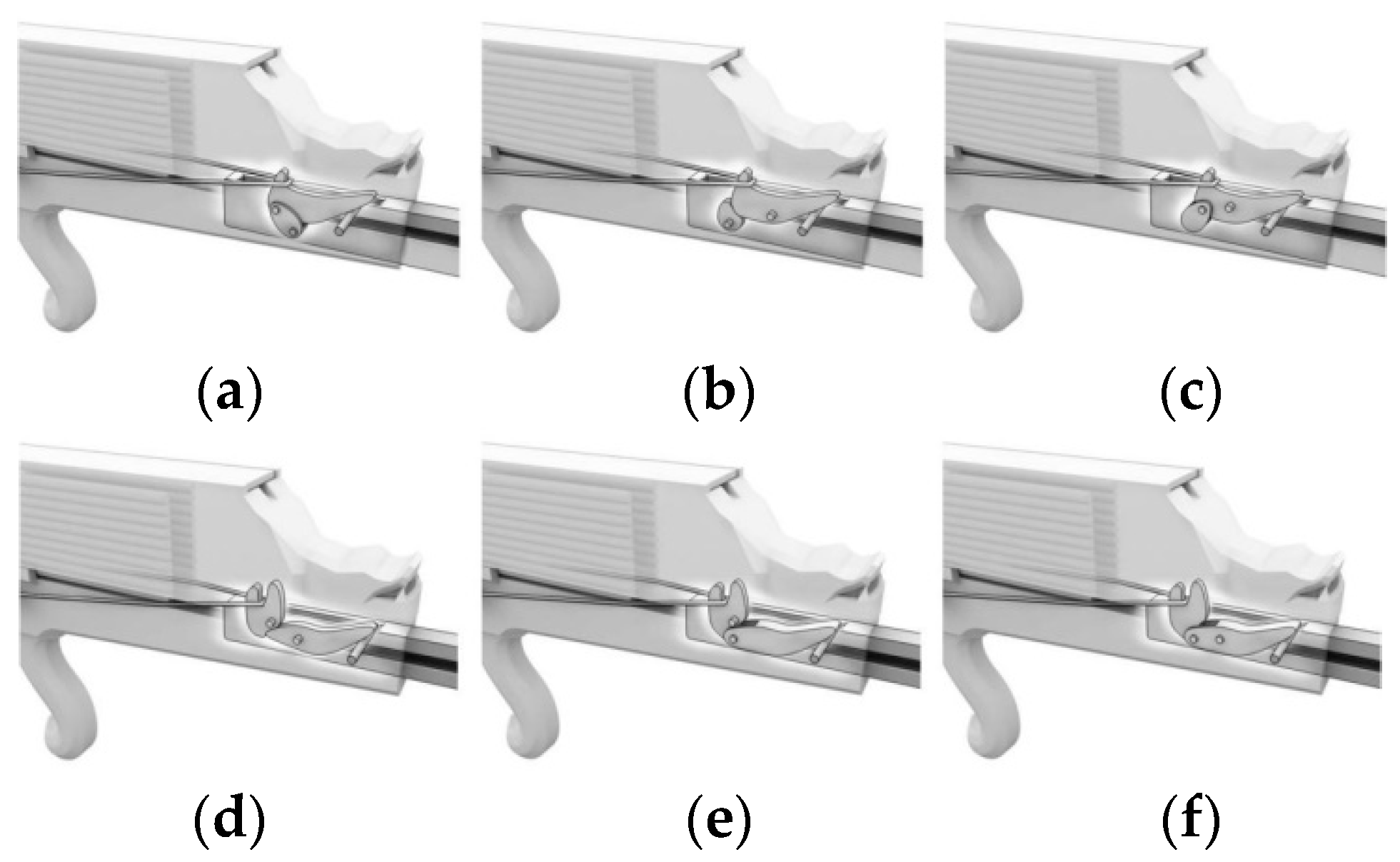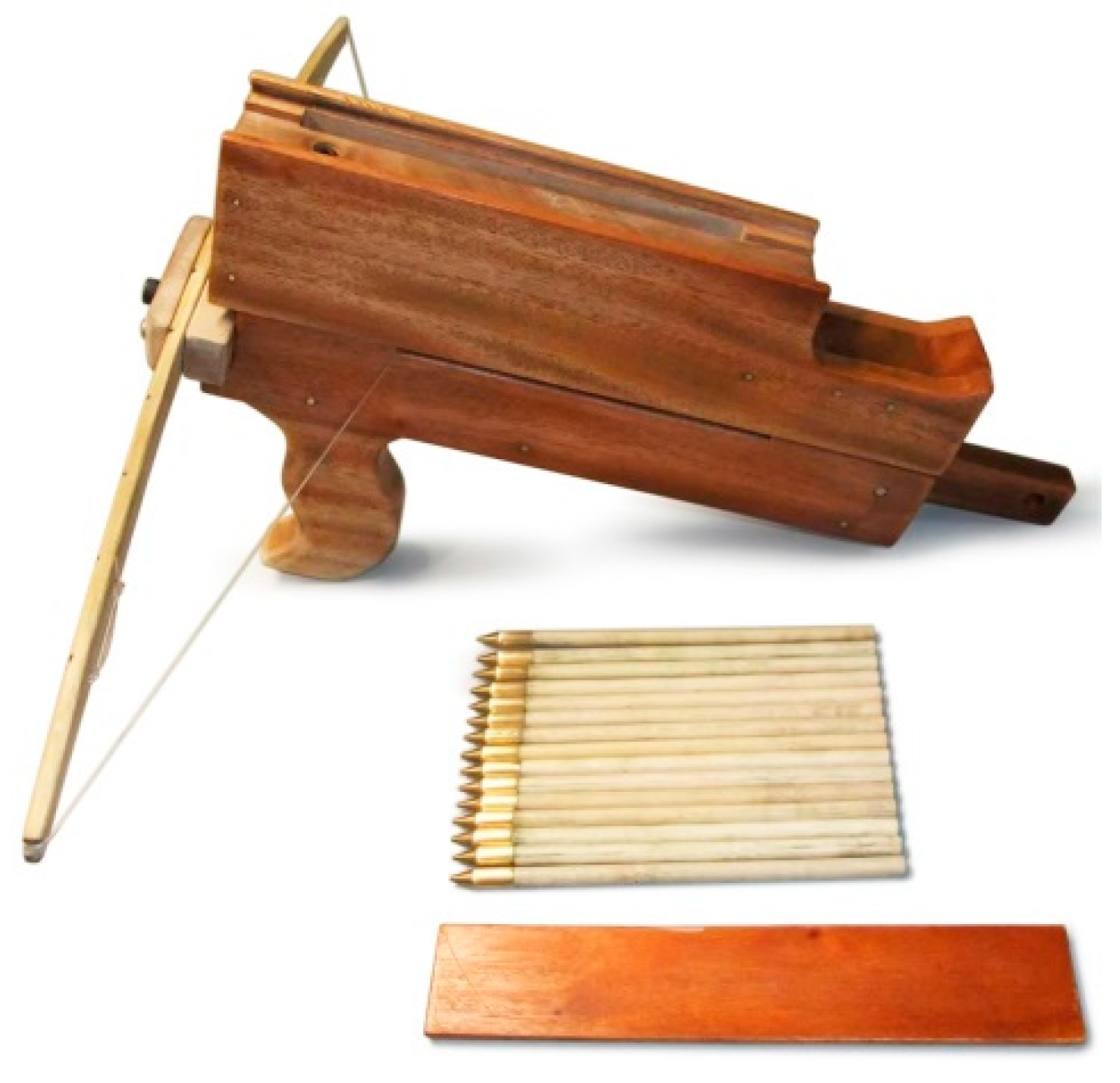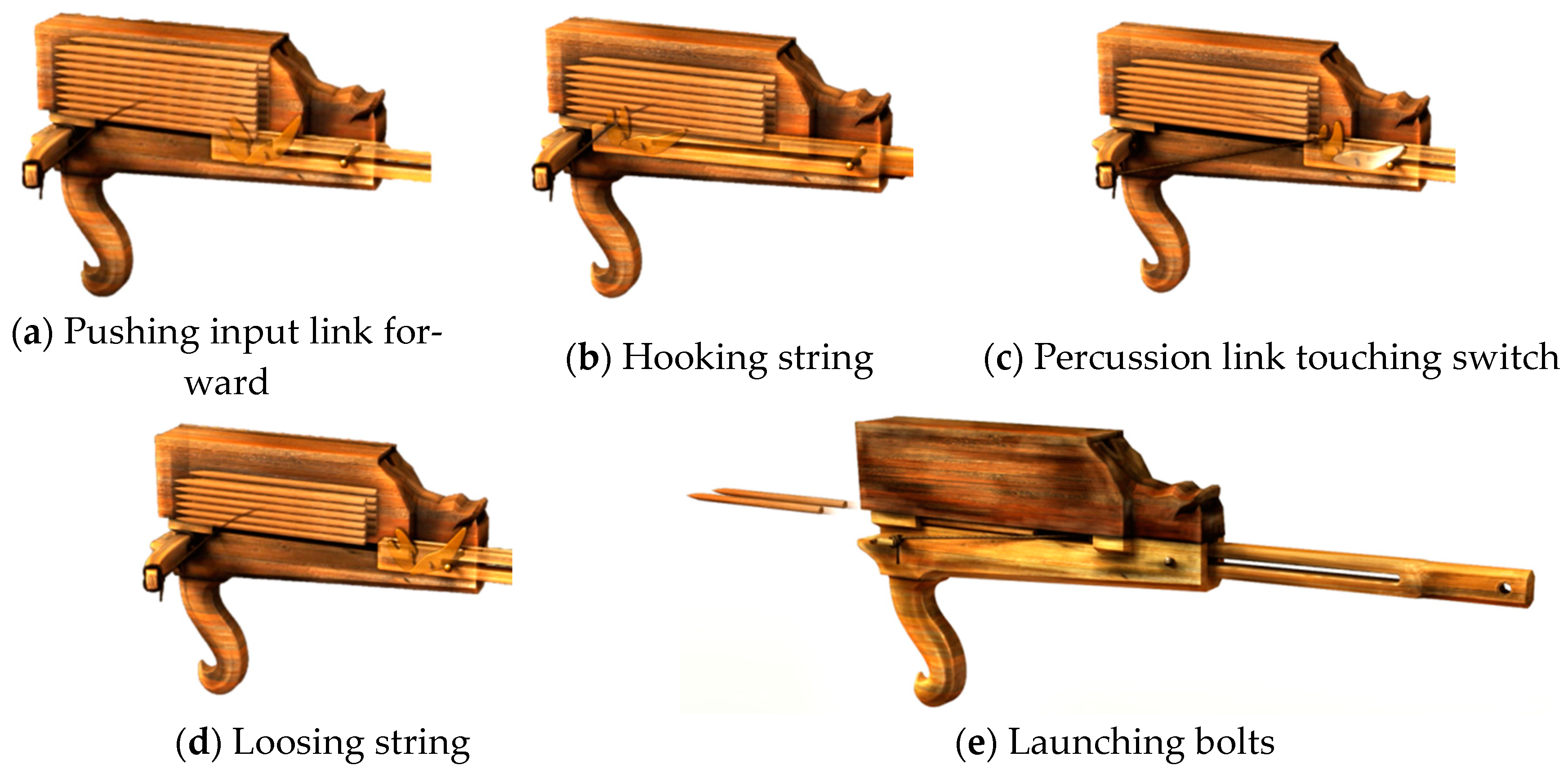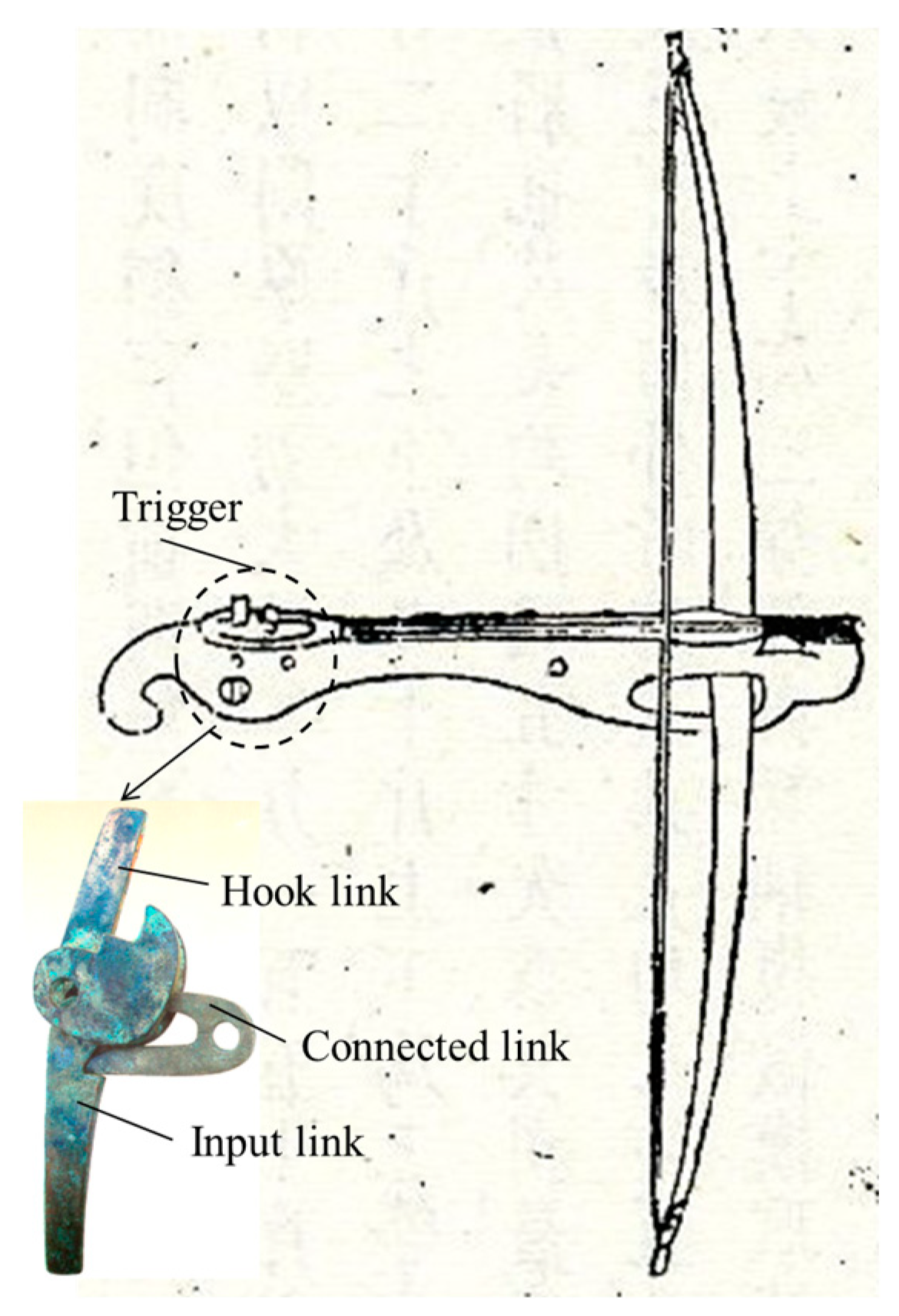1. Introduction
Numerous arrowheads made of animal bones or stones have been excavated in many Neolithic sites. It is generally believed that prehistoric humans had developed hunting tools, from rock slings to bows. The elastic force of the limbs and the string was used to shoot targets over a long distance with a bow. With the gradual evolution of bows and arrows, a diverse range of projectile weapons have been developed [
1,
2]. Among these weapons, the development of single-shot crossbows was most eminent; by adding a stock and a trigger to the original bow, the single-shot crossbow was updated to a bow with delayed shooting. As shown in
Figure 1, the trigger was operated with a cam mechanism using the input link, the connecting link, and the hook link [
3,
4]. To use a single-shot crossbow, the trigger was adjusted to the auto-locked state, then the crossbowman used arms or arms and legs to pull the string and hook it to the connecting link of the trigger. When the string was cocked tight, the crossbow was ready to shoot. When shooting, the crossbowman needed to tap the input link to loosen the string and eject the bolt. Single-shot crossbows overcame the three major shortcomings of original bows: manual cocking, the impossibility of long-time aiming, and a short shooting range. In 600 B.C., single-shot crossbows were widely used in the wars of ancient China. Since crossbows continued to be used until the early 20th century, they represented historic ancient weapons.
The crossbow shooting was conducted in four steps: string cocking, bolt placement, string release, and bolt launching. Shooting was completed with a repeating crossbow by operating the input link [
5]. According to archaeological findings, the earliest crossbow-enabled and repeated bolt launching in ancient China was excavated from an ancient tomb in Jiangling County of Hubei Province. Based on the location of the tomb and other relics found in the tomb, it was determined to be a tomb of the Chu State built in the Warring States period (475–221 B.C.). Since there is no historical record of this repeating crossbow, it is named the Chu State Repeating Crossbow after the excavated location. As shown in
Figure 2, the magazine containing 20 bolts of the crossbow was affixed to the stock [
6]. When the shooting was performed, the crossbowman held the input link (
KI(4)) and pushed it forward to hook the string to the hook link (
KL(6)). Then, the archer moved the input link backward until the percussion link (
KPL(5)) and touched the switch point. At this point, the two consecutive bolts were ready to launch. After a bolt was launched, the next bolt from the magazine was dropped down due to gravity and the next shooting was waited for. As the Chu State Repeating Crossbow used an ingenious mechanical structure, it is worthy of in-depth research and discussion. Based on the restored design of ancient crossbows, we formulated six feasible designs of the Chu State Repeating Crossbow. One feasible design was selected to construct its model using computer animation. The results have been already used for exhibition and science education in museums.
2. Structure Analysis
A crossbow was assembled from multiple link members and various types of joints. It has the function of string cocking and bolt launching for the operation of the input link. The Chu State Repeating Crossbow comprised six link members: the stock (Member 1,
KF), the bow (Member 2,
KCB), the string (Member 3,
KT), the input link (Member 4,
KI), the percussion link (Member 5,
KPL), and the hook link (Member 6,
KL) [
7,
8]. A bamboo joint (
JBB) was used to connect the bow and the stock between the string. The bow, the string, and the hook link in the thread joint (
JT) between the input link and the stock of the sliding joint (
JPx), the percussion link, the switch point (the stock) as the cam joint (
JA) of the input link, the percussion link, the hook link with two revolved joints (
JRx), and the cam joint (
JA) were all made of bamboo. The Chu State Repeating Crossbow consisted of six members and eight joints. The percussion link fixed the hook link so that the string could hook to the hook link; then, the string could be released when the percussion link touched the switch point by moving the input link to the extreme position. As shown in
Figure 3 [
7,
8], the restored design of a “6-member and 8-joint” Chu State Repeating Crossbow was constructed based on the restored design.
We analyzed the structure and summarized the structural characteristics, as follows:
The Chu State Repeating Crossbow adopts a “6-member (Members 1–6) and 8-joint” mechanism.
The stock (KF) is a three-joint link.
The bow (KCB) is a two-joint link that connects the adjacent stock (KF) with bamboo joints (JBB).
The string (KT) is a two-joint link that connects the adjacent bow (KCB) and hook link (KL) with thread joints (JT).
The input link (KI) connects the adjacent stock (KF) with the sliding joint (JPx), but is not adjacent to the string (KT).
The percussion link (KPL) connects the adjacent stock (KF) with a cam joint (JA).
According to the structure, the diagrams of the “6-member and 8-joint” mechanism [
9] were drawn as shown in
Figure 4.
A pair of adjacent two-joint links must be used as the bow and the string, which was adjacent to the three-joint link used as the stock. Therefore, only (a3) and (a6) in
Figure 4 met the requirements. All feasible specialized chains were obtained through the following steps.
Stock, bow, and string (KF, KCB, and KT)
A three-joint link was used for the stock (
KF), and a pair of adjacent two-joint links was used as the bow (
KCB) and the string (
KT) to be connected to the stock with bamboo joints (
JBB) and the thread joint (
JT). Therefore, they were designed as follows. Regarding the generalized chain in
Figure 4a3, the pattern of the stock, the bow, and the string was obtained as shown in
Figure 5.
Since the input link (
KI) connected the adjacent stock (
KF) to the sliding joint (
JPx), it had not to be adjacent to the string (
KT). Two feasible designs of the specialized chains of the stock, bow, string, and input link were obtained, which are shown in
Figure 5b1,b2.
Since the percussion link (
KPL) connected the adjacent stock (
KF) with the cam joint (
JA), only one pattern of the percussion link and the hook link was obtained, as shown in
Figure 5c1. For the case shown in
Figure 5b2, the pattern was obtained as shown in
Figure 5c2.
Then, a rectangular coordinate system was defined as shown in
Figure 2. Bolt shooting with the Chu State Repeating Crossbow was performed through the reciprocating motions of the input link. As the pattern of the original joints was uncertain with multiple possibilities, the uncertain joints were designed to have the specialized chains (
Figure 5c1,c2) in six feasible patterns (
Figure 5d1–d6). Considering the requirements for the movement and functions of the mechanism, all specialized chains with designated joints were visualized in the diagrams of the feasible mechanisms that conformed to the technical level of ancient craftsmanship. As shown in
Figure 6a–f, these diagrams were transformed into computer graphics.
3. Museum Applications
The International Council of Museums (ICOM) defines a museum as “a non-profit, permanent institution in the service of society and its development, open to the public, which acquires, conserves, and researches the heritage of humanity and its environment for education, study, and enjoyment” [
10]. Therefore, the museum collects, researches, exhibits, educates, and delivers information on the precious heritage of humanity to the public. The National Science and Technology Museum is the largest museum of applied sciences in Taiwan. Its main functions are research, collection, showing exhibitions of various science and technology themes, and the promotion of social scientific and technological education to introduce the impact of key scientific and technological development on human life. The Chu State Repeating Crossbow has an ingenious mechanical structure. It is the earliest repeating crossbow excavated and has a special historical position. Based on the restoration of the mechanism and the feasible design (
Figure 6d), the prototype was manufactured using computer simulation, as shown in
Figure 7 and
Figure 8.
Figure 9 shows the design of the DIY teaching aid for the relevant course for the promotion of science education.













